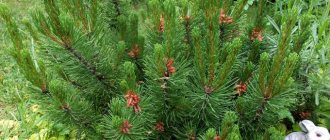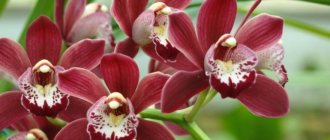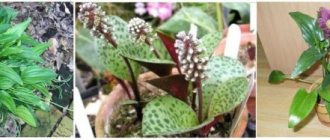Author: Natalya Category: Garden plants Published: February 21, 2019Republished: February 21, 2019Last edits: January 20, 2021
- When to plant
- Growing conditions
- Orange mimulus (Mimulus aurantiacus)
plant (lat. Mimulus), or gubastik, belongs to the genus of semi-shrub and herbaceous plants of the Frimov family, growing in temperate regions everywhere except Europe. Previously, this genus was included in the Norichnikov family. The Latin name mimulus flower received from the word mimus (translated as “imitator, mime”) because of its variegated, changeable colors, as well as because of the shape of the flower, similar to the face of a monkey. There are about 150 species in the genus Gubastiki, most of which can be found in western North America in damp places, as well as in mountains and deserts at altitudes of up to 2500 m above sea level. In our gardens, the sponge is still rare.
Description and features of mimulus
This is a perennial plant, but in the harsh weather conditions of Russia it is planted as an annual flower. However, there are also winter-hardy varieties that can easily tolerate down to -20 °C.
Subshrubs reach 1.5 m, and herbaceous plants - 0.7 m. The shoots are lying, prostrate or vertical, with pile or bare. They have heart- or egg-shaped leaves.
The buds are regular in shape, up to 50 mm in circumference. They have a corolla consisting of a bilobed upper labellium, curved back and a lower one, having 3 lobes, protruding forward. Petals are single-colored or spotted.
At the end of flowering, the fruit-pod begins to form, containing medium-sized brown seeds. After ripening, it cracks into a couple of parts.
Botanical description
Although the gubastik flower is a perennial, it is grown in culture as an annual plant, although some species can withstand frosts down to -20 ºC. Herbaceous species of mimulus reach a height of 70 cm, and subshrubs grow up to one and a half meters. The stems of the plant are branched, erect or creeping, bare or pubescent. The leaves are opposite, most often ovate. Irregularly shaped, monochromatic or spotted flowers up to 5 cm in diameter are collected in loose clusters. The corolla of the flowers is tubular, with a bilobed upper lip bent back, and a lower trilobed lip pushed forward. The fruit of the plant is a capsule with small brown seeds, which cracks in two when ripe.
Mimulus looks great in flower beds, rock gardens, hanging structures and containers. It is also used as a ground cover plant.
- Ratibida: planting and care in open ground
Types and varieties of mimulus
The genus includes about 150 species. However, only a few are cultivated.
Orange
The foliage is emerald, glossy. The flowers are orange or coral-pink. The stems need a support stick, otherwise they will begin to sag and creep. Can overwinter in a room with a low temperature.
Garnet
Grows in southern California and on the Mexican border with the states. The petals are iridescent, burgundy shades with an orange core.
Yellow
Originally from Chile. The shoots are vertical, branching, slightly pubescent, reaching 0.6 m. There are teeth along the edges of the leaf blades. Sunny buds are collected in apical or axillary inflorescences. This variety is not often found in Russian gardens.
Mottled
Initially it grew only in the western regions of the North. America, over time spread to the northern and eastern parts, New. Zealand, some European zones.
Grows up to 0.8 m. Stems are straight, branching. Lemon flowers with burgundy specks in the middle.
The most famous variety is Richard Bish. This is a variegated form with grayish-malachite plates with a pearl edging around the perimeter.
Red (purple)
Stems are pubescent, branching immediately from the base. The red or purple lipweed has ovoid leaves with teeth and protruding veins. Scarlet buds are located on elongated stalks in the axils of the greenery. The following varieties are planted in Russia:
| Name | Flowers |
| Auranticus | Reddish-red. |
| Cardinal | Fiery crimson with yellowish splashes. |
| Rose Queen | Large, pudding-like with dark flecks. |
| Red Dragon | Pomegranate. |
Copper red
Stems are bare, slightly erect. The buds are located on shortened axillary pedicels. At the beginning of flowering, copper-red or reddish. Over time they acquire a golden canary color. Common varieties:
| Name | Flowers |
| Red Emperor | Bright, crimson. |
| Andean Nymph | Beige, with soft lilac specks. |
| Rother Kaiser | Scarlet. |
primrose
Consists of thin shoots reaching 15 cm. The greenery is ovoid or oblong. Lemon flowers grow on developed stalks. The only variety capable of wintering outside.
Musky
A herbaceous plant with hair on its shoots and foliage. Produces mucus and emits a musky aroma. The shoots are spreading or vertically erect, up to 30 cm. The leaves are oval. The buds are canary-like, up to 25 mm in circumference.
Gaping (open)
The stems are branched, the leaf blades are rounded. The flowers of the open mimulus are small, pale lilac.
brindle
It also has other names: leopard, hybrid, large-flowered, maximus. This species includes all varieties obtained by crossing yellow and speckled mimulus. The tiger lip grows no more than 25 cm. The buds are multi-colored. This is a very popular variety among gardeners. The following varieties are especially popular:
| Name | Flowers |
| Feuer King | Reddish with brown spots and a yellowish core. |
| Sun in the shade | Various tones. |
| Viva | Canary-colored, with large burgundy spots. A distinctive feature is early flowering. |
| Magic Spots | Snow-white beige, with raspberry splashes. |
| Magic Mix | Plain or two-color, with pastel petals. |
| Twinkle Mix | One color or several. There are different tones: from pearl to rich crimson. |
| Brass Monkeys | Speckled, brightly rusty. |
Classification of Mimulus
Lily is a garden flower with a pyramidal appearance.
Mimulus hybrid has about 150 varieties. In nature, another 120 varietal individuals are distinguished. Some varieties are especially popular, while others are grown by some gardeners.
Note! The species is non-standard in all respects, which is why flower growers love to grow the crop in flower beds.
Tiger mimulus (Mimulus tigrinus)
It is also called Mimulus tigrinus, Mimulus grandiflora, Mimulus leopardum, hybrid lipweed (Mimulus hybridus), Mimulus maximus. It is the most popular variety that gardeners especially love to grow in their gardens. The plant is annual. The height of the bush is 20-25 cm. The inflorescences look like brushes. The buds have a variety of colors, but always variegated. Flowering continues from May to July.
What does a tiger look like?
Orange mimulus (Mimulus aurantiacus)
Aurantiacus is a bush 1.2-1.3 m high. The variety loves warmth. The ability of the stems to bend beautifully during the flowering period adds additional decorativeness to the look. Each tubular flower has 5 petals. The color spectrum ranges from white to red. Aurantiacus blooms from May to early September.
Pomegranate sponge (Mimulus puniceus)
The height varies from 20 to 40 cm. A feature of the species is the deep red color of the buds, which is as close as possible to pomegranate.
Yellow lipstick (Mimulus luteus)
The sponge of the species Mimulus luteus has a bush about half a meter high. The flowers are fiery yellow. The peduncles are slightly lowered, since the buds are quite large due to the huge petals with wavy edges.
Speckled mimulus (Mimulus guttatus)
A miniature variety, the length of the stems reaches a maximum of 20 cm. It can be annual or perennial. The flowers are large, bright yellow, and have brown spots on the lower petal.
Red sponge (Mimulus cardinalis), or purple sponge
A bush 30-40 cm high is usually crowned with bright red flowers. The petals are oval and have no additional spots. It emits a pleasant aroma, which is not typical for the culture.
Mimulus red has a unique aroma
Copper red mimulus (Mimulus cupreus)
The plant has a small stem height of 15 cm. This is an annual crop. Mimulus cupreus got its name due to the copper-red color of its petals. Flowers are also characterized by a different color, but close to the main shade.
Primrose lipstick (Mimulus primuloides)
Primrose sponge is a perennial flower, but in gardens it is often grown as an annual. On the herbaceous above-ground part there are many small yellow flowers. The blooming of new buds continues from May to September.
Mimulus primrose on the site
Musk mimulus (Mimulus moschatus)
This is a herbaceous species of mimulus that can secrete mucus with a nutmeg scent. The entire surface of the leaves and stems is covered with small fibers. The flowers are small in size, 2.5 cm, and yellow in color. The height of the bush can be 30 cm.
Mimulus ringens, or open mimulus
A special feature of the variety is the bud. The color may vary and the shape is unique. The buds are maximally open, which is why the flower looks far from the standard representative of mimulus.
Growing mimulus from seeds
Sowing is carried out:
- in boxes for seedlings;
- into the ground onto the street.
The first option is preferable, since with the second method the bushes begin to form buds only in August or September.
Sowing
Sowing in pots is carried out in the 2nd ten days of March or the 1st half of April:
- Prepare containers with airy substrate with medium acidity or peat tablets. A universal nutrient soil mixture containing coconut fiber and perlite is suitable. You can purchase it at any specialized store and add sand there yourself.
- Distribute the seeds over the surface, mixing with large grains of sand. Because The seed is small and cannot be scattered evenly. Therefore, picking will be necessary in the future.
- There is no need to cover it with soil. Just moisten with a spray bottle.
- Cover with polyethylene or glass to create a greenhouse effect. Remove the cover daily to ventilate, eliminate condensation and moisten with a sprayer with a fine nozzle.
- Place the container in a room with good lighting. The optimal temperature is +15…+18 °C.
- Shoots can be observed after a couple of days.
Growing seedlings
After most of the sprouts have appeared, the container must be moved to a temperature of +10...+12 °C. This is necessary so that the young shoots do not begin to stretch. Watering should be done daily, preferably in the late afternoon. Spray regularly with a fine spray bottle.
After the formation of the fourth true sheet begins, pick into separate containers. Transplant 3-4 sprouts into each pot. A few days later, when the plants have adapted to the new location, add potassium mixture in ½ the dosage indicated on the package. Feed again after 7-10 days.
Description
The name of the plant translated means magician, artist . Apparently, this is due to the spotty, highly variable color of the flowers. With their shape they resemble the face of a monkey, which is why in their homeland they are called monkey flowers. In our country, mimulus are known as gubastics.
These herbaceous perennials or annuals are native to wet, swampy areas of western North America. Some species are found in New Zealand, Australia, East Asia, and Chile. They bloom from April to July, surviving drought in a dormant state. With the onset of the rainy season, lipsticks come to life again.
On average, mimulus reaches a height of 10 to 60 cm. Some representatives of the genus are subshrubs that grow up to two meters. On their creeping or erect stems grow broadly lanceolate, opposite leaves with sharp serrations. Loose racemose inflorescences consist of original flowers of various colors. The corolla, tubular at the base, is divided into two lips . The lower three-lobed lip is protruded forward, and the upper one consists of two lobes. The fruit of the gubastik is a two-lobed seed capsule.
Planting mimulus in the garden
2 weeks before planting, the seedlings need to be hardened off: taken outside daily. Start with 15 minutes, gradually increasing the time.
When sowing directly into the garden, the seeds do not need to be buried in the substrate. It is enough to cover with film until shoots appear. When they get stronger, remove the cover and thin out the sprouts.
Timing for planting seedlings and seeds in open ground
The optimal time is the second half of May - the first ten days of June. When the likelihood of frost returning disappears and the ground thaws completely.
In the southern regions of our country, planting takes place in the 2nd half of April. This can be done provided that for several days the average daily temperature was +15...+18 ºС.
Landing technology
Sponge grows well in partial shade and open areas. However, in strong sunshine, the greens may wilt or burn. Choose loamy soil, with a sufficient amount of humus and peat, and low acidity. Step-by-step disembarkation:
- Dig up the area, level it, moisten it abundantly.
- Dig holes large enough to fit the rhizome of the bush along with a lump of earth. Leave 20-30 cm between them.
- Water the soil mixture in the pots to make it easier to pull out the shoots.
- Move the seedlings using the transshipment method.
Transplantation and propagation
Any type of mimulus can reproduce by self-seeding. To quickly obtain an adult bush, many gardeners prefer to propagate flowers by cuttings. In the summer, after flowering, the cuttings are cut, transplanted into a pot with loose sandy soil, and covered with a bag for better rooting. After 2 - 3 weeks, cuttings take root quite quickly. Planting of vegetatively grown sponge is done as soon as the cuttings have roots. A less common method of propagation is dividing the bush. It is used in the spring before flowering begins.
Transplanting seedlings into open ground or returning an overwintered plant back to the flowerbed is carried out only by transshipment, in order to preserve the root system. In case of damage and loss of part of the roots, the plant will bloom weakly and will devote all its energy to restoring the underground part.
Growing from seeds
In the spring, in mid-April, seeds are planted immediately in open ground. The soil, enriched with fertilizer and sand, is moistened, and the seeds are applied to the ground in an even layer. Cover the bed with a glass cap or transparent covering material for 2.5 weeks, the first shoots are thinned out, forming future flower beds. This method is less effective compared to seedlings.
Mimulus care
Spongeweed is easy to grow from seeds and maintain. However, in order for it to bloom magnificently and not get sick, you must follow these simple rules:
| Factor | Recommendations |
| Watering | Regular, especially in hot, dry weather. The top layer of soil should always be moistened. When small holes appear on the plates, this indicates that the number of waterings needs to be reduced. |
| Top dressing | Apply potassium-phosphorus fertilizers under the base once every 4 weeks (15 ml of mixture per 10 liters of water). Feed additionally after pruning. |
| Loosening and weeding | Perform after each watering. |
| Trimming/pinching | The bush blooms twice per season: in spring and early autumn. After the first wilting of the buds, trim the inflorescences. Soon new shoots will grow, the secondary flowering will be more colorful. It is necessary a few weeks after planting to make the bush more full. |
| Transfer | Needed for specimens growing indoors. Produced twice a year: in early spring and in summer during the break between flowering. |
Pests and diseases of mimulus
Very rarely mimulus is damaged by pests. Sometimes you can find aphids, which can be easily controlled by treating the plants with some kind of insecticide. Even less common is whitefly. In open ground conditions, this pest does not cause significant harm.
Among the diseases, powdery mildew occurs in cold and rainy weather. To prevent this disease, treat with Topaz in early June. In hot weather there is a risk of gray mold. But this disease is rare.
Diseases and pests
Lipstick is a resilient and healthy plant that is rarely affected by diseases and insects. However, problems may arise with weak shoots:
| Disease/pest | Signs | Control measures |
| Blackleg |
|
|
| Powdery mildew |
|
|
| Gray rot |
|
|
| Gastropods |
|
|
| Aphid |
|
|
| Whitefly |
|
|
Types, varieties
Popular types of mimulus:
- Red. The height of the bushes is up to 40 cm. The flowers are fiery red, fragrant. There are varieties with pink (“Cardinal”, “Rose Queen”), burgundy (“Red Dragon”), and orange flowers (“Auranticus”).
- Tiger (hybrid). A low-growing plant up to 25 cm, the flowers come in a variety of colors. Popular varieties of this species: “Viva” (hybrid F1) - bright yellow flowers with red spots, Magic Spots - cream flowers with crimson specks, Brass Monkeys - orange petals speckled.
- Leopard print. It is distinguished by large flowers with a diameter of up to 6 cm. Compact, ideal for planting in window pots and containers. The flowers are bright yellow, with a scattering of small spots of burgundy. The height of the stems is up to 25 cm.
- Yellow. The stems are up to 60 cm high and have slight pubescence. The flowers are bright yellow, monochromatic, forming inflorescences in the form of a brush.
- Primrose. Bushes up to 15 cm high, flowers pale yellow.
- Tricolor. It is a herbaceous plant reaching a height of 14 cm. The flowers are pink with yellow, white, and burgundy spots.
- Orange. It is distinguished by erect stems up to 1.2 m long. The color of the flowers is light orange, but there can also be white and red shades.
- Mottled. It has straight or creeping stems 10-80 cm long. The flowers are large, bright yellow, with spots of various shades.
The variety “Winter Sunset” is popular. The flowers have 2 shades: bright pink, snow-white. The plants are compact, bloom for a long time, and are resistant to frost.
Mr. Summer Resident recommends: mimulus in the landscape
Since mimulus are moisture-loving, they are often grown as plants for ponds. They decorate the shores of lakes, ponds, bays, etc.
Indoors (for example, in country gazebos or loggias) the flower looks harmonious with lobelia and verbena. And if you plant it in tandem with matthiola, they will exude an incomparable aroma. Sponge grass is planted with the following herbaceous plants for open ground:
- function;
- false spirea;
- sitovnik.
On alpine slides it is combined with:
- wild dill;
- ivy;
- stone rose;
- buttercups;
- garden viola.
Even an inexperienced amateur gardener can grow mimulus. This does not require specific skills or a lot of free time. If all care recommendations are followed, the sponge will decorate the garden from early summer to late autumn. It will fit perfectly and enhance any landscape design.
Mimulus reproduction
If the conditions of your garden are suitable for mimulus, then the plant will soon begin to reproduce by self-sowing. But it is still better to propagate especially valuable types of mimulus vegetatively - using green cuttings.
The best way to propagate mimulus is cuttings
Cuttings of the plant are carried out in the summer. A cutting with two internodes is cut from an adult, thriving plant and planted in a container with sand. To maintain humidity, put on a plastic bag. Typically, cuttings readily produce roots by the end of the third week.
Application in landscape design
Mimulus is good for decorating small flower beds and gardens. Often used as a container plant in garden and balcony tubs or hanging planters. Due to its moisture-loving nature, mimulus is popular among owners of garden ponds - it is used to decorate banks in flooded areas.
Mimulus on the shore of a pond
In balcony boxes, mimulus goes well with lobelia and verbena. And by planting it in a tub with matthiola, you will get a flower garden with an incomparable aroma. In open ground, mimulus, as a representative of shade-tolerant plants, goes well with decorative leafy hostas, flowering astilbe and rush. In the rock garden it looks beautiful with saxifrage, periwinkle, juvenilia, buttercups and viola.
Sowing seeds for seedlings
You can buy sponge seedlings at gardening stores or grow them yourself. If you want to grow mimulus seedlings from seeds, you need to follow the instructions below.
- You can collect planting material after the flower blooms, when the fruit boxes are fully ripe. Seeds can also be purchased at the store.
- Seeds should be planted no later than the first half of April, but some varieties with an early flowering period can be sown as early as the end of February.
- To plant mimulus seeds at home, it is better to choose nutritious, neutral or slightly acidic soil (up to 5.8 acidity level). A universal soil for garden plants is also suitable here, but you will need to add humus, peat and sand to it. Ideally, the substrate for planting gubastica seeds should include turf, leaf soil, peat, sand and humus in a ratio of 1: 2: 1: 1: 3.
- For planting seeds, it is best to use wooden or polymer boxes, but be sure to have holes for moisture drainage. Small plastic cups or ceramic pots also work well here.
- First, high-quality drainage from gravel or broken brick is placed in containers, then soil is carefully placed, which is loosened and wetted with a sprayer.
- The seeds of the sponge are very small, so you need to handle them with a toothpick. Try to distribute the planting material evenly throughout the container, maintaining a distance of at least 2-3 cm between the seeds. There is no need to deepen the seeds, just press them down a little.
Further seed care also includes a number of specific activities.
After planting the seeds, the soil in the containers is sprayed again with a spray bottle, then the containers are placed in a warm place (with a temperature of at least 18 degrees) and covered with film or glass. It is very important to control the frequency of watering and not allow the soil to dry out or become waterlogged. In some cases, mold appears under the film on the ground - this is a sign that the container needs to be ventilated occasionally. As soon as the first sprouts of sponge appear, the seedlings are placed in a cooler room with good lighting
Ideally, the temperature should not drop below 10 degrees, humidity should not exceed 80%. If there is not enough lighting in the room or it is regularly a cloudy day outside, special lamps are installed above the seedlings. Approximately 7-8 days after the sprouts appear, the soil in the containers is fertilized with a complex fertilizer containing nitrogen and potassium. The following feedings are carried out at intervals of 10-12 days. As soon as the sprouts have 3 healthy petals, they are transplanted into separate containers - peat pots or paper cups with a volume of at least 150 ml are best suited here. Up to 3-4 seedlings can be placed in each container.










